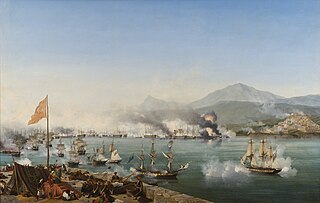
A civil war is a war between organized groups within the same state . The aim of one side may be to take control of the country or a region, to achieve independence for a region, or to change government policies. The term is a calque of Latin bellum civile which was used to refer to the various civil wars of the Roman Republic in the 1st century BC.
The Iraq War began in 2003 and involved a two-phase conflict comprising an initial invasion of Iraq led by U.S. and UK forces and a longer, eight-year phase of occupation and fighting with insurgents.

In political science, a proxy war is as an armed conflict fought between two belligerents, wherein one belligerent is a non-state actor supported by an external third-party power. In the term proxy war, the non-state actor is the proxy, yet both belligerents in a proxy war can be considered proxies if both are receiving foreign military aid from a third party country. Acting either as a nation-state government or as a conventional force, a proxy belligerent acts in behalf of a third-party state sponsor. A proxy war is characterised by a direct, long-term, geopolitical relationship between the third-party sponsor states and their client states and non-state clients, thus the political sponsorship becomes military sponsorship when the third-party powers fund the soldiers and their matériel to equip the belligerent proxy-army to launch and fight and sustain a war to victory, and government power.

An insurgency is a violent, armed rebellion by small, lightly armed bands who practice guerrilla warfare against a larger authority. The key descriptive feature of insurgency is its asymmetric nature: small irregular forces face a large, well-equipped, regular military force state adversary. Due to this asymmetry, insurgents avoid large-scale direct battles, opting instead to blend in with the civilian population where they gradually expand territorial control and military forces. Insurgency frequently hinges on control of and collaboration with local populations.

Wars of national liberation, also called wars of independence or wars of liberation, are conflicts fought by nations to gain independence. The term is used in conjunction with wars against foreign powers to establish separate sovereign states for the rebelling nationality. From a different point of view, such wars are called insurgencies or rebellions. Guerrilla warfare or asymmetric warfare is often utilized by groups labeled as national liberation movements, often with support from other states.
Congolese Civil War or Congo War may refer to any of a number of armed internal conflicts in the present-day countries of the Democratic Republic of the Congo and the Republic of the Congo in Central Africa.
War in Afghanistan, Afghan war, or Afghan civil war may refer to:
Irregular warfare (IW) is defined in United States joint doctrine as "a violent struggle among state and non-state actors for legitimacy and influence over the relevant populations." In practice, control of institutions and infrastructure is also important. Concepts associated with irregular warfare are older than the term itself.
The history of guerrilla warfare stretches back to ancient history. While guerrilla tactics can be viewed as a natural continuation of prehistoric warfare, the Chinese general and strategist Sun Tzu, in his The Art of War, was the earliest to propose the use of guerrilla warfare. This directly inspired the development of modern guerrilla warfare. Communist leaders like Mao Zedong and North Vietnamese Ho Chi Minh both implemented guerrilla warfare in the style of Sun Tzu, which served as a model for similar strategies elsewhere, such as the Cuban "foco" theory and the anti-Soviet Mujahadeen in Afghanistan. While the tactics of modern guerrilla warfare originate in the 20th century, irregular warfare, using elements later characteristic of modern guerrilla warfare, has existed throughout the battles of many ancient civilizations.

Political violence is violence which is perpetrated in order to achieve political goals. It can include violence which is used by a state against other states (war), violence which is used by a state against civilians and non-state actors, and violence which is used by violent non-state actors against states and civilians. It can also describe politically motivated violence which is used by violent non-state actors against a state or it can describe violence which is used against other non-state actors and/or civilians. Non-action on the part of a government can also be characterized as a form of political violence, such as refusing to alleviate famine or otherwise denying resources to politically identifiable groups within their territory.

Kurdish separatism in Iran or the Kurdish–Iranian conflict is an ongoing, long-running, separatist dispute between the Kurdish opposition in Western Iran and the governments of Iran, lasting since the emergence of Reza Shah Pahlavi in 1918.







